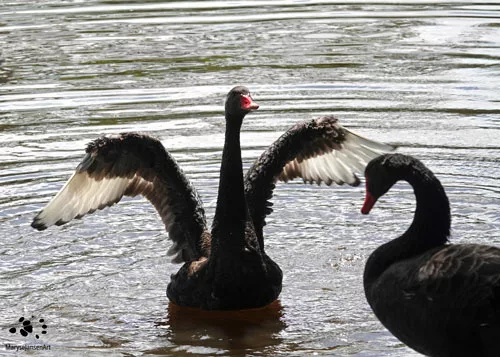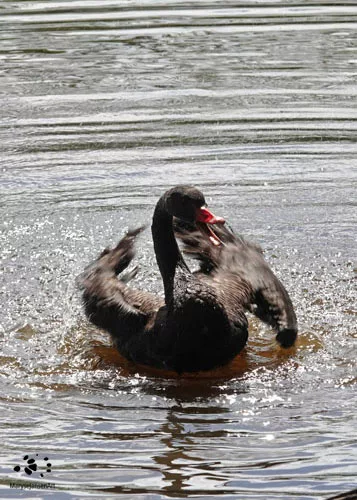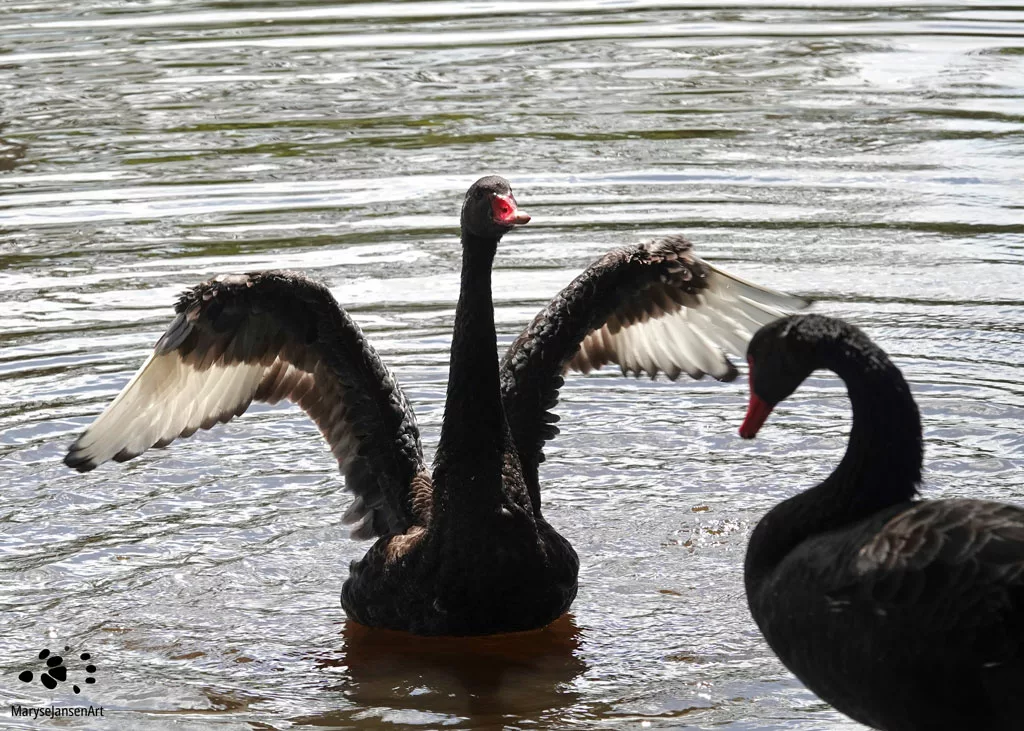Bird Photography with marysejansenart
Famous waterbird displays some unexpected behaviours!

Table of Contents
Black Swans are not all black
What a spectacle! A bathing Black Swan draws my attention. Repeatedly it ducks its head in the water to scoop up some water. It then straightens and flaps its wings to shower itself and in that moment it reveals a surprise! The Black Swan is not entirely black! When it opens its wings I can see that they are half white! What a stunning sight!
The only other colour on this bird is the characteristic bright red bill. The keen observer will notice a white stripe across the bill. It continues to flap and splash around while the two other swans watch the display from their resting position on the edge of the lake.
Black Swans are native to Australia
Another surprise to me, as I was so used to seeing these birds in the Netherlands, is that the Black Swan is native to Australia! The bird was a real curiosity to early European explorers as at the time it was believed that all swans were white. They introduced the bird to Western Europe and it became a popular ornamental bird. Many escapees have settled successfully since coming to Europe. But right here I can observe it in its natural habitat!

Black Swans need a long runway
The bird prefers to feed on aquatic plants and algae. When the water is shallow it plunges its long neck under water while the rest of its body remains horizontal. When trying to reach greater depths it will tip its hind up in the air. Only when food is scarce, the Black Swan will feed on land, as it’s not very good at walking.
The Black Swan is common in eastern and south-western Australia and seeks out large water bodies with either fresh, brackish or salt water. The swan migrates in response to weather conditions, following the rain as that is where it will be able to find food. Even though the bird is capable of flying long distances, there are some surprising complications!
Firstly, the swan requires a long stretch of clear water of at least 40 metres for take-off so you can be sure it will never visit your garden pond!
Furthermore, after breeding season, the bird moults and loses all its flight feathers. It then is unable to fly for about a month! To stay safe, it will spend its time on a large, open body of water, often in the company of other Black Swans.
Black Swans can be unfaithful to their partner
Black Swans form strong pair bonds. The female builds a nest that consist of a tall mound of vegetation in the reeds or floating on the water and lays 5-6 eggs. The incubation period lasts about 5-6 weeks and the duty of breeding is shared by the male and the female. After hatching, the cute little cygnets are very light in colour. They will gradually darken as they grow older. They spend about 2-3 weeks on the nest and then stay in the family group for up to 9 months.
No surprises here so far, but it turns out that even though the swans form strong pair bonds and were thought to mate for life, they are actually not sexually monogamous. The male swan can never be sure that he is the biological father of his offspring. Nevertheless he takes good care of them!
Gay couples raise young successfully
Even more interesting is the fact that amongst the pairs are also gay couples in the form of male-male pairs! And you might be surprised to learn that these male-male pairs have higher success rates of raising a brood then male-female couples do!
Obviously they would need to get hold of eggs somehow. It might be that they find an abandoned nest that they adopt, perhaps one of them mates with a female and she leaves after laying or possibly the pair steals a nest from another pair? But once they’re in charge they are reported to be very successful because they share the workload more equally and their territorial behaviour gives them access to better nesting sites and territories.
Check out the bathing swan in action in my new episode of ‘Come for a walk in the Australian Bush’ below!
If you are interested in purchasing ‘Two Black Swans’ or would like to see what the image looks like on the various products, please head to my shop.


